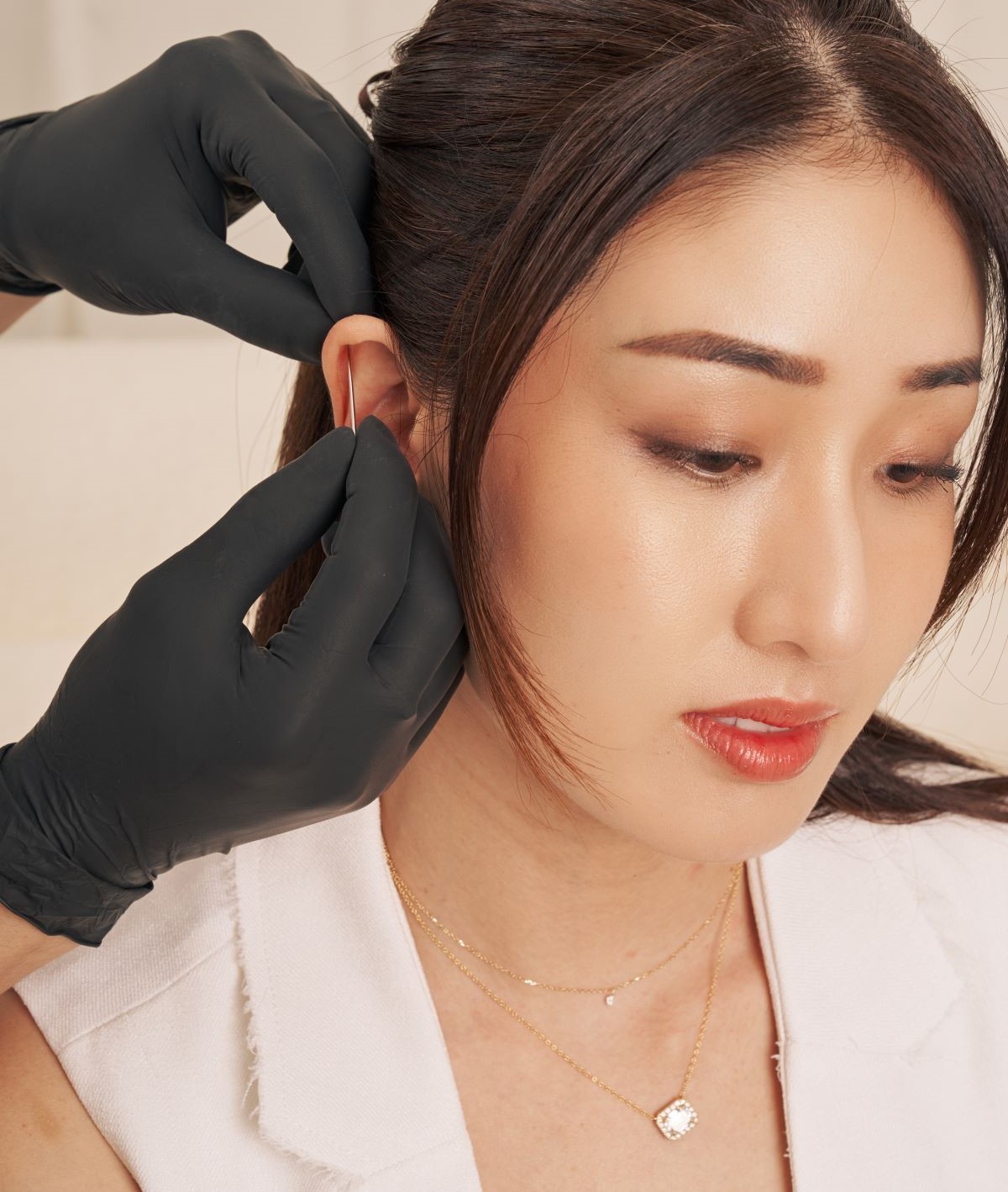
Once you have your dream piercing(s), learn the best ways to take care of it. We've put together a little guide here, from cleaning instructions to lifestyle adjustments to ensure that your piercing heals properly without any unnecessary discomfort.
A compression technique for cartilage piercings will be taught by our piercer after the procedure. Do follow instructions and apply the compression technique once a day, after cleaning your piercing.
The approximate healing time for an earlobe piercing is 2 to 4 months, and a cartilage piercing is 6 to 12 months. Everyone heals at a different rate but whether or not you follow your aftercare can shorten or lengthen the healing process.
During the healing process, the jewelry may not move freely in the piercing; do not force it. Don’t change out or remove your jewelry until your piercing is healed. If you have questions, check with our piercer.
Please note that these are suggested guidelines based on a combination of vast professional experience, common sense, and research. This is not to be considered a substitute for medical advice from a doctor. If you think you have an infection or symptoms such as excessive swelling, soreness, redness or pus, please seek medical attention immediately.
01 CLEANING INSTRUCTIONS
- Wash your hands thoroughly before cleaning your piercing. A piercing is an open wound and unnecessary touching of a healing piercing will increase the chances of an infection.
- Clean your piercing gently, twice a day until it is fully healed.
- Soak a clean cotton bud with sterile saline solution or sterile saline spray and clean both the front and the back of your piercing.
- Use only sterile saline solutions with NO additives for cleaning.
- Do not clean your piercing with harsh products such as Dettol, Betadine, alcohol, Neosporin, or Bactine as these products could cause irritation.
- Moisture can lead to bacteria infection. Dry the area well with sterile non-woven gauze or use the cold setting on a hairdryer.
________________
02 TIPS & BEST PRACTICES
- Avoid overcleaning.
- Do not remove your jewelry during the healing process as it will begin to close immediately.
- Do not turn or rotate your jewelry, it is not necessary.
- Refrain from putting body creams, makeup, moisturizers, and perfumes directly on the piercing.
- In the shower, try to keep soaps or shampoos away from the area and rinse thoroughly after.
- Do not pull or pick the dried matter because it is attached to the healing tissue.
- Be cautious when putting on glasses, wearing masks, washing, drying, tying your hair, putting on and removing clothing.
- Avoid sleeping on your piercing. Sleeping on your piercing increases the chances of inflammation, infection and irritation bumps. It can also cause your piercing to migrate and heal at a bad angle.
- Avoid swimming or submerging the piercing in bodies of water as it may contain bacteria and harsh chemicals that interferes with the healing process.
- Stay healthy. The healthier your lifestyle, the easier it will be for your piercing to heal. Get enough sleep and eat a nutritious diet high in Vitamin C and Zinc. Exercising is fine, but remember to keep your piercing clean and dry after.
- Avoid seafood and foods that are raw or undercooked. Seafood contains histamine forming bacteria that may cause complications during the healing process. Raw or undercooked food may still contain bacteria and viruses that can directly or indirectly affect the healing process too.
- Make sure your bedding is washed and changed regularly.
________________
03 WHAT IS NORMAL?
- It varies from one person to another.
- Within the first few weeks: Some bleeding, localized swelling, tenderness, bruising or mild pain.
- Within the first 2-4 months: Some discoloration, itching, and secretion of a whitish-yellow fluid (not pus) that may form some crust on the jewelry can occur. You skin may tighten around the jewelry as it heals.
- Once healed: The jewelry may not move freely in the piercing; DO NOT force it. If you fail to include cleaning your piercing as part of your daily hygiene routine, normal but stinky bodily secretions may accumulate.
- A piercing may seem healed before the healing process is complete. This is because tissue heals from the outside in, and although it feels fine, the interior remains fragile. BE PATIENT and keep cleaning throughout the entire healing period.
- Even healed piercings can shrink or close in minutes after having been there for years! This varies from person to person; if you like your piercing, keep the jewelry in! Do not leave it empty.
- If your jewelry feels loose, book a follow up appointment to come in for a downsize.
- Downsizing is not suitable for every piercing. Our piercer will advise you on whether or not it is necessary for a downsize after you receive your piercing.
- You can start monitoring your piercing 2 months after the day you got pierced. Most piercings are only ready for downsizing after 4 months. Do not book an appointment if your piercing is still exhibiting signs of an unhealed wound.
To book a downsizing appointment, contact us at pierced@curiouscreatures.cc, tell us your name and the date you got pierced.
________________
04 HOW TO COPE WITH SWELLING
*At any point if you experience excessive swelling, soreness, redness or pus, please seek medical attention immediately*
- Non-steroidal anti-inflammatory products such as Ibuprofen (Advil, Motrin, etc.) may help reduce inflammation during the healing period.
- Icing the piercing site with a soft gel ice pack can help reduce swelling during the initial stages of healing.
- Try a compression technique:
i. Cold Compress
Apply a clean, soft gel ice pack directly on your piercing for the first 3 to 5 days to help reduce the discomfort, swelling, bleeding, and bruising that can accompany a fresh piercing. Use a clean ziploc bag containing cold water if you do not have a soft gel ice pack. Too much moisture can disrupt a fresh scab resulting in prolonged bleeding. Place the ice pack on your piercing for 10 minutes, remove it for 10 minutes before reapplying for another 10 minutes. One cycle is half an hour. Do this once a day before cleaning your piercing.
Follow instructions carefully; icing too long can cause tissue damage (ice burn) and reduced blood flow, which can lengthen the healing process.
ii. Warm CompressAfter the first 3 to 5 days, if initial bleeding has stopped, you may begin using warm compresses. They can feel soothing, diminish swelling, and stimulate circulation. Heat causes an influx of oxygenated blood, which brings in more nutrients to help repair injured tissues and flush out debris. Warm compresses can be dry or moist.
iii. Moist Compress
Wash your hands and soak a clean washcloth, paper towel, or lint-free gauze in hot—but not scalding—water. Use a sterile saline spray. Heating it in a microwave is fine. If possible, check the water temperature with a thermometer. It should be no hotter than 48°C. Wring out the compress and apply it until it no longer feels warm, then reheat and reapply. Repeat for fifteen to twenty minutes, up to two times daily.A simple option is to spray saline onto gauze squares, heat until warm to the touch in a microwave, and apply.
Following the application of heat or cold, your skin should look pink, not bright red, and never blistered! When finished, gently pat the area dry with a clean paper towel, tissue, or gauze.
